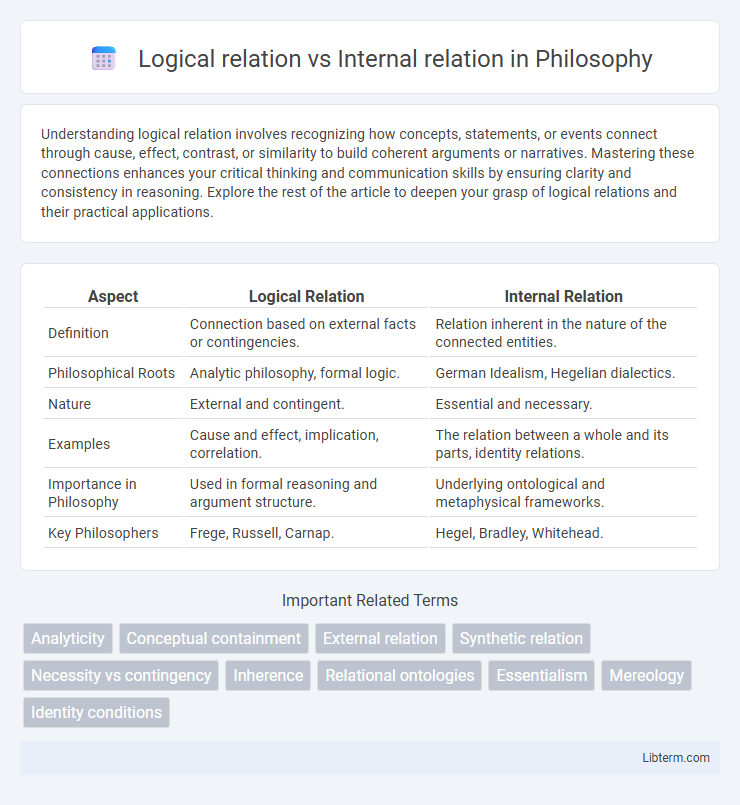Understanding logical relation involves recognizing how concepts, statements, or events connect through cause, effect, contrast, or similarity to build coherent arguments or narratives. Mastering these connections enhances your critical thinking and communication skills by ensuring clarity and consistency in reasoning. Explore the rest of the article to deepen your grasp of logical relations and their practical applications.
Table of Comparison
| Aspect | Logical Relation | Internal Relation |
|---|---|---|
| Definition | Connection based on external facts or contingencies. | Relation inherent in the nature of the connected entities. |
| Philosophical Roots | Analytic philosophy, formal logic. | German Idealism, Hegelian dialectics. |
| Nature | External and contingent. | Essential and necessary. |
| Examples | Cause and effect, implication, correlation. | The relation between a whole and its parts, identity relations. |
| Importance in Philosophy | Used in formal reasoning and argument structure. | Underlying ontological and metaphysical frameworks. |
| Key Philosophers | Frege, Russell, Carnap. | Hegel, Bradley, Whitehead. |
Introduction to Logical and Internal Relations
Logical relations connect propositions through formal structures like conjunction, disjunction, and implication, ensuring truth-functional dependencies in reasoning processes. Internal relations, by contrast, describe inherent connections between entities or concepts where the relation is essential to their identity, such as the part-whole relationship within objects. Understanding these distinctions clarifies how logical frameworks govern valid inference while internal relations ground ontological dependencies in philosophy and cognitive science.
Defining Logical Relations
Logical relations are defined as connections between propositions or statements governed by formal logic rules, such as implication, equivalence, or contradiction. Internal relations involve inherent, necessary connections between the properties or concepts themselves, independent of external context or formal systems. Defining logical relations emphasizes the structural and truth-functional aspects that determine the validity and inferential links within logical reasoning.
Understanding Internal Relations
Understanding internal relations involves recognizing that the connection between entities is essential and intrinsic, meaning the related entities cannot be conceived independently of each other. Internal relations differ from logical relations, which are external and do not depend on the essence of the connected entities. This distinction is crucial in metaphysics and philosophy, where internal relations define the fundamental nature and identity of objects through necessary connections.
Key Differences between Logical and Internal Relations
Logical relations involve connections between propositions based on formal logical rules and consistency, essential in reasoning and inference processes. Internal relations are inherent connections between entities that depend on the very nature or identity of the related entities themselves, making them indispensable and non-contingent. Key differences include that logical relations are externally imposed rules applied to abstract propositions, while internal relations are intrinsic and cannot be altered without changing the entities involved.
Historical Background of Logical vs Internal Relations
The distinction between logical relations and internal relations originated from 19th-century philosophy, particularly in the works of G.W.F. Hegel and later expanded by Charles Sanders Peirce and Bertrand Russell. Logical relations refer to connections between entities that hold independently of the nature of the related objects, grounded in abstract, formal logic, whereas internal relations imply that the relation is essential to the identity or nature of the related entities. Russell's early analytic philosophy challenged Hegelian internal relations by advocating that all relations are external, sparking ongoing debates in metaphysics and logic about the fundamental nature of relational structures.
Philosophical Perspectives on Relations
Logical relations are abstract connections between concepts or propositions, grounded in the principles of logic and often considered external to the entities involved. Internal relations, emphasized by philosophers like G.E. Moore and F.H. Bradley, assert that the related entities inherently depend on these relations for their identity and nature. The debate around these relations centers on whether relations are independent structures or fundamentally constitutive of the relata themselves in metaphysical frameworks.
Examples Illustrating Logical Relations
Logical relations, such as synonymy and antonymy, define connections between concepts based on formal logic principles; for example, "all bachelors are unmarried men" illustrates a logical entailment. Internal relations depend on the inherent nature of objects or concepts, like the relationship between a triangle's three sides determining its shape. Logical relations establish necessary truths applicable across contexts, whereas internal relations are contingent on the internal properties of the entities involved.
Examples Illustrating Internal Relations
Internal relations are essential connections where the properties or existence of one entity intrinsically depend on another, such as the relationship between an object and its parts or the correlation between cause and effect within natural phenomena. For example, the relationship between a book and its chapters exemplifies an internal relation because the chapters inherently belong to and define the book's structure. Similarly, the connection between a person's mental beliefs and their actions demonstrates an internal relation, as the beliefs naturally influence behavior in a way that cannot be separated without altering the nature of the relationship.
Implications in Philosophy and Logic
Logical relations, fundamental in formal logic, denote connections between propositions based on truth-functional dependencies, such as entailment and equivalence, which underpin deductive reasoning and validity assessment. Internal relations imply an inseparable, ontological connection where the relata's identities depend on their relationship, a topic explored in metaphysics and the philosophy of logic concerning the nature of objects and properties. Understanding these distinctions informs debates on how meaning, necessity, and conceptual analysis operate within philosophical logic and semantic theory.
Conclusion: Comparing Logical and Internal Relations
Logical relations, such as implication and equivalence, depend on the formal structure of propositions and remain invariant regardless of the specific content. Internal relations, by contrast, exist inherently between the entities involved, making the related entities inseparable and their relation essential to their identity. Comparing these, logical relations are abstract and truth-functional, while internal relations are ontologically fundamental, highlighting a key distinction in the philosophy of logic and metaphysics.
Logical relation Infographic

 libterm.com
libterm.com